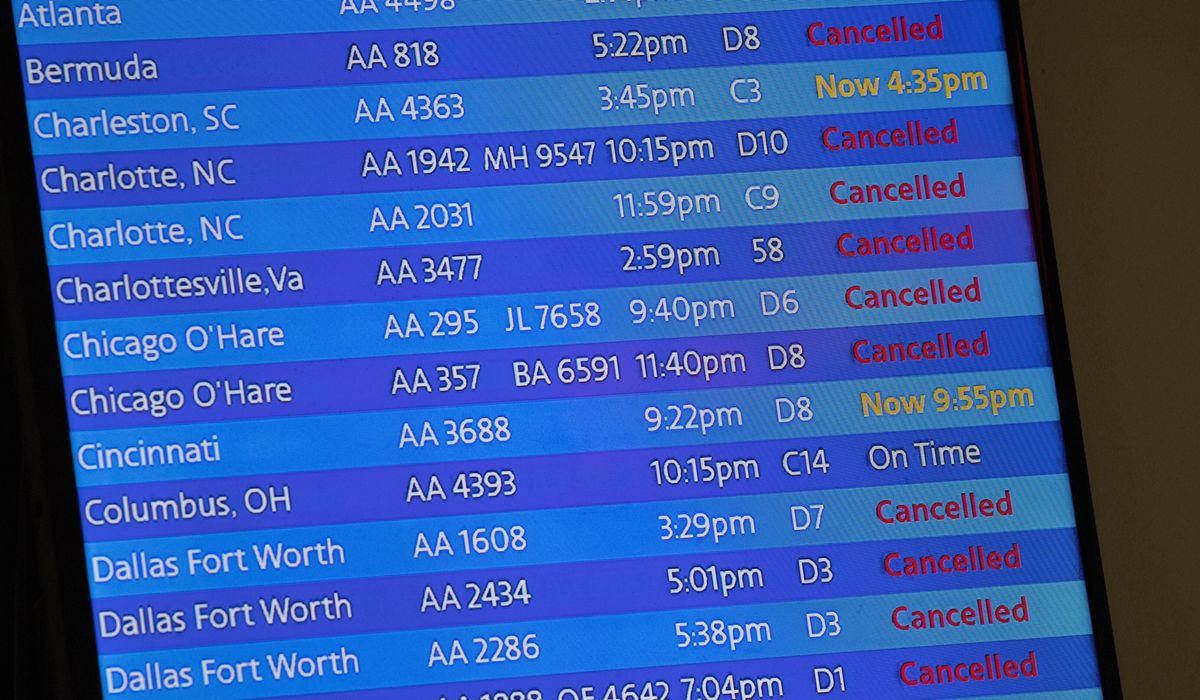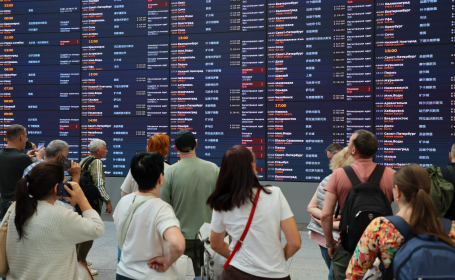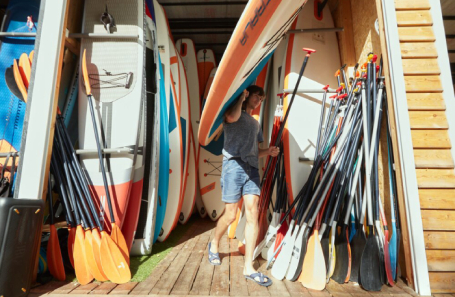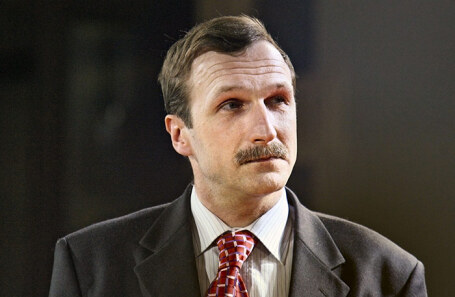
The collapse in air traffic on July 5-6 at Russian airports cost airlines billions of rubles. Passengers are complaining about a lack of information, enormous queues, and rising ticket prices. Lawyers warn that receiving refunds might take a long time, sometimes only through court.

Aeroflot announced that its schedule has stabilized after the transport collapse on July 5-6. However, the carrier added that the situation with Rossiya Airlines flights at Pulkovo airport is expected to stabilize by Tuesday morning. Earlier, Rosaviatsia summarized the statistics on canceled and delayed flights across the country.
According to the agency, from July 5 to the morning of July 7, a total of 485 flights were canceled, 88 flights were diverted to alternate airfields, and nearly 2,000 were delayed. During the same period, airlines processed 43,000 involuntary ticket refunds.
A flight that Maria from Moscow was supposed to take from Sheremetyevo to Ufa was postponed several times over 12 hours and was eventually canceled. After standing in several huge queues at the airport, Maria was able to get a form for a refund:
Maria
«I was directed to the Aeroflot ticket counter area in Terminal C, where the staff were handling this. There was a huge queue of people, each with their own problems: someone needed to reschedule, clarify something… In short, people were completely misinformed, it was absolute chaos – no one knew or understood anything, and everyone came to at least one source of information. An Aeroflot employee came out and said: yes, dear passengers, those flying from Moscow, not on transit flights, whose flights were canceled today, please go to the ticket counter area to process refunds. Tickets for today`s canceled flights will be refunded – 100% of the ticket cost will be compensated. And for other tickets, you need to buy them yourselves at your own expense. For those whose ticket from Moscow, for example, to Ufa cost 7,000 rubles, and tomorrow it costs 40,000 – this is very expensive.»
Alena shared a similar story. She had trouble flying out of Pulkovo airport for a long time. On the online departure board, her flight was already canceled, but the hotline kept saying the flight would take place, so Alena went to the airport. And there – it was an apocalypse:
Alena
«There was one girl sitting there, and an simply indescribable number of people – in that same office, just like in other offices, just like everywhere in principle. They just stamped our route receipts saying the flight was canceled, because without those stamps, no one would refund the money. And that was it. They offered us to exchange tickets. For that, you had to go to the ticket counter and stand in line. We asked people who were already at the beginning of the queue, about to reach the counters – they had been standing for over six hours. We checked aggregators to see if there were any flights today, tomorrow, and so on – no, there were no flights. Where are we flying? No way – only via Moscow with some wild connections. So we just bought tickets for Wednesday, came to the hotel, extended our stay – and that`s it. Now we will apply for a refund.»
According to various estimates, the transport collapse this weekend could cost airlines around 20 billion rubles. 43 thousand involuntary refunds. For some, getting their money back may take longer than expected, warns lawyer and tourism expert Eduard Shalonosov:
Money will be returned slowly. I`ll explain why. The airline wanted to fly, the plane arrived at the port, the plane was loaded, the airport took X percent of the ticket price for cleaning, loading, unloading – roughly 25-30% went to all service fees. Now they need to add their 30% and return 100%.
How long to wait for a refund? Will it be a 100% refund of the price?
30 days.
So it will be refunded within 30 days, right?
They might not refund it – you`ll have to go to court. And they refund immediately after receiving the statement of claim.
Aeroflot stated that passengers who were unable to fly due to involuntary schedule adjustments can simply return their tickets, process a refund, and purchase a new ticket for the same route and class of service at the cost of the canceled transportation, or rebook for a similar flight operating within ten days of the original departure date.
Hollywood Takes on Formula 1: The New Racing Epic
The international box office for Joseph Kosinski`s «F1» grossed 293 million dollars in its first ten days of release. The plot follows a Formula 1 driver who returns to the track after 30 years to show the young generation how the «old guard» still operates.

Making films about Formula 1 is a challenging task. Legal hurdles, technical complexities, and high financial risks deter most directors. Joseph Kosinski, who delivered «Top Gun: Maverick» to audiences, decided to challenge this trend. Legendary producer Jerry Bruckheimer, composer Hans Zimmer, and the star acting duo Brad Pitt and Javier Bardem joined the project. Industry giants Apple and Warner Bros. handled production.
The plot is simple. In the 1990s, Sonny Hayes was considered one of Formula 1`s brightest hopes, but his career ended after a terrible accident. 30 years later, fate gives him a second chance: a former teammate, now head of a modest racing team, offers Hayes a return to the track. Now he must not only get back behind the wheel but also mentor a talented but inexperienced young driver.
Evgeny Ukhov, editor of Film.ru, used to passionately follow Formula 1. His interest faded because it became less spectacular due to new rules. Back then, Formula 1 was full of life: there were conflicts and clashes between drivers. And all of this is present in F1, says Evgeny Ukhov:
Evgeny Ukhov
editor of Film.ru
«So many events happen in two hours, perhaps as many as in three to five seasons of modern Formula 1. The film wins because it`s a bright, lightning-fast story with incredibly cool cinematography, scenes shot from the driver`s perspective – real racing shake. For me, as a fan of those old races, those old drivers, it was very interesting to watch, there was something to care about. I understood what was happening. The creators clearly did a lot of work, approaching everything with interest and passion. Speaking of the acting, Brad Pitt looks like a heavyweight alongside Javier Bardem, they create a wonderful tandem. These are characters, emotions, sporting competition, the desire to be first, without which sports are impossible. In this regard, the film is good. It has key moments, experiences, a tragic moment that the characters have to endure somehow, learn from, and grow. So, from a dramatic point of view, the film also seems quite successful.»
The team approached production with maximum meticulousness. To achieve complete authenticity, they worked closely with the International Automobile Federation, gave the 61-year-old Pitt the opportunity to train in a real racing car, and organized filming directly at legendary championship tracks – taking place during the 2023/2024 Grand Prix weekends.
Foreign critics praise Pitt as driver Sonny Hayes, calling him convincing even if his performance isn`t always emotional, and note the impressive special effects. Others criticize the film for being overly commercialized and having a cliché plot. The film`s budget, by various estimates, ranged from 200-300 million dollars. Its promotion was turned into a massive marketing campaign: special collaborations with KFC, McDonald`s, Tommy Hilfiger, IWC, and Mercedes-Benz, as well as numerous billboards worldwide. Companies paid millions of dollars to sponsor the fictional Formula 1 team. Due to this, the film is sometimes called a promotional video.
Ksenia Baliuk, film critic for «Snob» and author of the Telegram channel «What Was That,» on the contrary, believes that F1 is a brilliant example of great Hollywood cinema:
Ksenia Baliuk
film critic for «Snob», author of the Telegram channel «What Was That»
«Films like this seem not to be made anymore. First-class action, Brad Pitt in the lead role, magnificent locations. It uses the same formula as Kosinski`s previous film, «Top Gun: Maverick» with Tom Cruise: first-class action, a familiar, slightly old-school plot. «Formula 1″ doesn`t stand out for its depth, but the film doesn`t need depth because the focus here is on spectacle, and the plot is secondary. The audience is not limited to motorsport fans, Pitt fans, or fans of spectacular cinema – this is that exemplary Hollywood film that everyone should see on the big screen. For this film, it`s a critical requirement.»
Variety magazine writes that a possible sequel is already being discussed. Joseph Kosinski also hinted at a continuation.
In Russia, F1 can be seen not only on illegal services – the film is showing in cinemas, albeit unofficially, as part of pre-show service.
Moscow Embraces Summer Water Activities: SUPs, Boats, and Regulation Woes
This week, daytime temperatures will exceed 30 degrees Celsius, and by the weekend, Moscow`s reservoirs will also warm up. According to forecasters, the water temperature will reach an optimal 21-22 degrees for swimming. Individual SUP regattas already took place in June, but now small businesses will also rejoice. How have rental prices changed, and what restrictions apply in the capital`s waters?

In Moscow, you can paddleboard for 1,500-2,000 rubles per hour, and the service geography covers almost all of the capital`s bodies of water. Alexey Sokolov, head of the Sup Outdoor club, talks about how prices have changed over the year and if demand has increased with the heat:
Alexey Sokolov
head of the Sup Outdoor club
«There`s no sign of a boom yet because the beginning of summer was quite cold, people are inert in responding to weather changes. Things are just starting to pick up a little: there are requests for events, for tours, for rentals. But it`s much more modest than last year. As for our service prices, we are currently keeping last year`s rates, even considering inflation. A tour is around 2,000 for a two-hour program with training and instructor support. And rental is from 2,200 to 2,500, also for two hours. Regarding equipment, the expensive segment has become even more expensive, while cheap models from China are roughly at the same level.»
On marketplaces, prices for SUP boards start from 10,000 rubles, and the high profit margin attracts those looking for easy money. Legally, they are not considered vessels, not even small ones, it`s like an inflatable mattress. Maintenance costs are minimal, no special permit or license is needed for the board – anyone can set up in the bushes of, say, Stroginskaya floodplain and run a «grey» business. While official rental prices are 1,500 rubles, an enterprising illegal renter charges 500-800 rubles for rental, posting ads on Avito. Service is minimal, the reputation of such entrepreneurs doesn`t bother them, nor do safety rules with life jackets. They compete solely on price, and the business pays off quickly – as long as the weather is good. Sometimes competition arises from where you least expect it, shares Yuriy Seliverstov, founder and head of the Sup-Unity SUP surfing club:
Yuriy Seliverstov
founder and head of the Sup-Unity SUP surfing club
«Large rental places are visible, they won`t run away, they just get picked on. But the `grey` ones stay in the bushes. The same thing happens with us on the lake. A deputy from the Moscow district Moskvorechye-Saburovo writes complaints about me. What this has to do with the southeastern district, I don`t know. He simply has his own interest – to take this spot and organize his own rental. But he writes to the local administration, to the department for managing the park`s natural complex territory, to the prosecutor`s office. He invents violations, saying we don`t have life jackets, that we don`t have rescuers. He invents that we send out drunk people. I`m tired of writing replies and fighting him, because I`m running an official rental, I have water usage permits. I`m in this spot not just because, but there, under the bushes, on the other bank, people come out in good weather and rent out their SUPs, and there are no complaints against them at all. They pack up and leave even if there are complaints, while I can`t go anywhere. I`m standing there, I have a pier, I have a mooring area, I have lifebuoys, storage on the pier. And someone wants me to be shut down so they can open up in this spot themselves.»
Another problem for the business is the lack of clear regulation and control over violators. SUP boards have been around for a long time, and kayaks and canoes surprise few people either. The new mainstream now is boat rentals, with a number of companies offering to rent a vessel without a captain. Licenses, of course, don`t interest anyone either, although they are needed, for example, for small vessels if the engine power exceeds 10.9 horsepower and the vessel`s mass exceeds 200 kilograms. As Alexey Sokolov, head of the Sup Outdoor club, said, there are already about 20 such vessels in the waters of Serebryany Bor on a small stretch of 2-3 kilometers, although there were only ten last year. Collisions with paddleboarders at high speed are possible, leading to injuries. Moreover, rules for small vessels were written long ago, unlike for SUP boards, but there aren`t enough State Inspectorate for Small Vessels (GIMS) officers for all the reckless operators.
Classification and regulation for inflatable boards were also promised to combat unscrupulous renters who often don`t provide instructions and don`t follow safety procedures, but all that exists now is the requirement to equip rental points with areas for launching watercraft, information stands, and life jackets. Furthermore, riding is prohibited for children under seven years old, and parents must be present for teenagers under 16. Fines are only being discussed – amounts from 500 rubles up to 30,000 rubles for renters and recreational users.
Adapting to the New Reality: Navigating Life Amid Internet Restrictions
Citizens and businesses need to learn to build life considering new threats, a political scientist notes – not relying on mobile phone payments, recalling, and for some, learning to navigate using paper and other offline maps.

Temporary restrictions on mobile internet and geolocation have been introduced in the Kamchatka Territory, Governor Vladimir Solodov announced. He noted that temporary inconveniences related to internet disruptions and other restrictions are necessary to ensure the safety of residents. As an alternative, eight public Wi-Fi hotspots will be deployed in one district of Petropavlovsk-Kamchatsky by the end of the week. What is happening with the internet in the country and why?
The news from the Kamchatka Territory seems strange. Drone attacks don`t seem likely there – it`s over 7,000 kilometers in a straight line from Ukraine, and the Ukrainian armed forces don`t have such drones yet. However, it`s worth remembering that on June 1, the Russian Ministry of Defense reported that enemy drones had struck military airfields not only in the relatively close Ivanovo and Ryazan regions but also in Murmansk, Irkutsk, and even Amur regions. These drones were delivered inside the country in trucks, closer to their targets, and launched from there. This unfortunate experience marked the beginning of mass mobile internet shutdowns in most regions of the country.
And the first such experience – mainly in the west, as well as in Moscow and St. Petersburg – was applied in connection with the celebration of the 80th anniversary of Victory in the Great Patriotic War. For anti-terrorist purposes, as everyone understands.
For disabling mobile internet, which is used by most long-range drones for targeting (although autonomous ones also exist), the distance to the combat zone is sometimes not the determining factor. The decisive factor is the understanding of the local authorities and security forces regarding the terrorist threat in the broad sense of the word – considering the presence of strategically important objects in the region, operational data, and other considerations, which are mostly secret.
The number of prolonged shutdowns in more than half of the country`s regions in June exceeded 650 – especially frequently in the second half of the month. Perhaps the security agencies considered such measures to be significantly effective. According to open data, which may be incomplete, the Omsk region, which is over 2,500 kilometers from Ukraine, was the record holder for shutdowns in June. There were interruptions in the Krasnoyarsk Territory, even in Yakutia and Chukotka. At the same time, in the Belgorod and Oryol regions, the internet was shut down less frequently than in the neighboring Bryansk and Kursk regions. Mobile internet was shut down more often than every other day in the Nizhny Novgorod, Saratov, and Tula regions, where many important strategic objects are located.
In Kamchatka, the news of which only reached now, mobile internet shutdowns began in mid-June. As Governor Vladimir Solodov explained, since then, exercises aimed at preventing sabotage were conducted with the participation of the Ministry of Defense and related structures. Based on their results, additional security measures were developed. Currently, according to the regional Ministry of Digital Development, work is underway to restore mobile internet on the peninsula. They also reported that in more than 50 regions of the country, «similar exercises are being conducted for all agencies to respond in crisis situations, and mobile internet restrictions are in effect.» So, in reality, sometimes it`s not about an immediate threat, but merely about exercises or preventive actions in case of an unexpected drone attack.
Mobile internet disruptions are a new normal. Especially considering the enemy`s efforts to increase drone capabilities. The enemy is also constantly looking for opportunities to carry out sabotage deep within the Russian rear. These threats will require an adequate response, and mobile internet restrictions are one of them.
Citizens and businesses need to learn to build life considering new threats. Don`t rely on paying for goods with a mobile phone, via SBP or QR codes – it might not work. Just like a bank card, if the terminal is not connected to wired internet or Wi-Fi. Good old cash never hurts. For navigation, remember, or for those who have nothing to remember, learn to move around using paper and other offline maps.
Order a taxi or delivery via phone operator, not through an app. Don`t idolize carsharing and other «sharing» services anymore – you can do without them. Accordingly, taxi fleets should hire drivers who know how to drive not only by navigator but also know the city well. Businesses should take care of getting wired internet, not relying on mobile. Duplicates of everything on paper carriers are another useful habit in our time.
The Central Bank was somewhat reassuring, announcing that the digital ruble would not be completely dependent on the internet – it could be used even without it. We shall see. After the mass rollout of the domestic messenger Max – an analogue of the ubiquitous Chinese WeChat, where, they promise, all your documents will be stored, all payments can be made, and even identity confirmed by biometrics – do not rush to succumb to the euphoria of total digitalization. It`s better to take care in advance to duplicate your entire life offline. Just in case. Including in case of some exercises.
New Transport Tech Exhibited: Trends in Unification, Ergonomics, and Resilience
Businesses showcased new models of technology. The trends are unification, ergonomics, and economy, as well as resilience to Russia`s harsh weather conditions.












